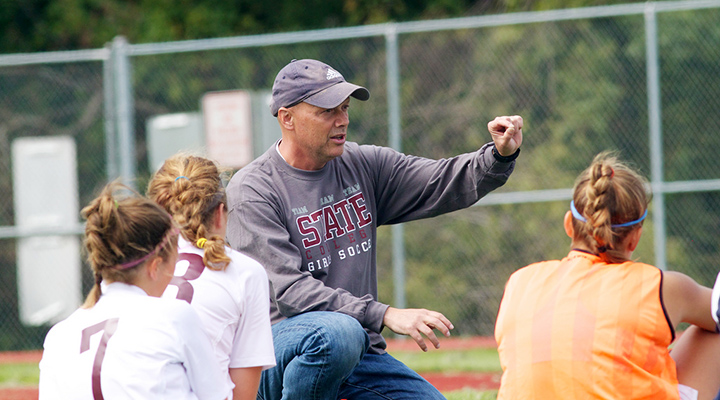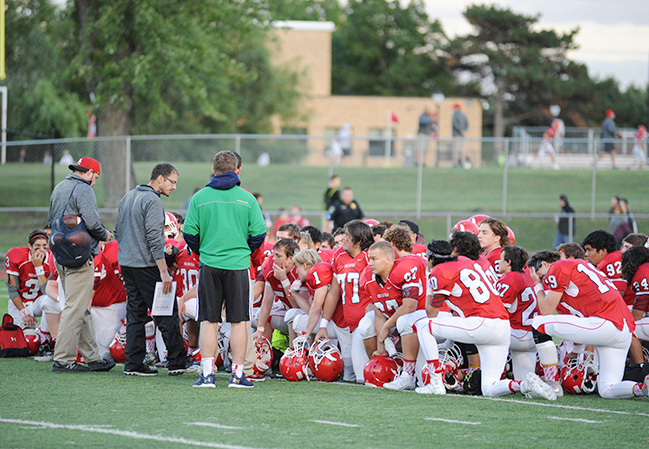A recipe for failure
Four ways coaches hinder success, and how they can turn it around

Coaches are tasked with developing and cultivating success, athletic improvement, confidence and positive attitudes. With regularity, I find myself examining my own coaching strategies to ensure that I’m striving to provide an atmosphere and culture that achieves these goals. I review skill development, the needs of the athletes I work with, and the messages I’m providing regarding winning and losing.
… Our fields, gyms and tracks are our classrooms. Embracing that concept is vital to maintain credibility as a coach.
As I coach, officiate and observe other coaches at their craft, I’m not surprised to come to learn that we are our own worst enemies. Too often, we set up our athletes for failure. We lose sight of their needs and place our own egos, agendas and vision ahead of the athletic and character growth of our athletes.
When I first began coaching, I was idealistic in my approach and I had a “vision” for what I wanted my program to look like. In turn, I ignored the reality of how I was setting up my players for failure.I learned that there were four key areas where I was creating an atmosphere for failure with my athletes.
1. Keeping athletes who receive no playing time.
All athletes want to play, and the days of athletes being happy just to be part of the team are over. Kids have other options for athletics, so if an athlete is not getting an opportunity with you, they will find that opportunity someplace else.
Think back to your own careers as young athletes. You worked hard, ran and dealt with the emotional, social and intellectual challenge of learning new skills, strategies and game day preparation. Every athlete wants the chance to be successful. They will make mistakes, and no athlete leaves practice with the dream and ambition of sitting on the bench. They want to be in the game.
Keeping an athlete and not allowing them the real opportunity for success only causes you more headaches, all of which are your own creation. Instead of a few instances dealing with a frustrated parent and disappointed player who didn’t make the team, you now have the parent who calls and emails you twice a week along with a player who will cause you grief for a few months instead of a few days. In that time, the player resents you and develops a negative outlook on the game they used to enjoy or even love.
Developing a realistic set of expectations for your athletes where they understand their roles is key to their success and your ability to play them on a regular basis. By no means do I suggest equal playing time across the board. Rather, I’m advocating for playing time as a predictable and regular occurrence that our athletes can embrace.
If they know their roles and you have communicated them clearly, then playing time issues can be minimized.
2. Lack of communication.
Communication is not only vital, it’s the life’s blood of our craft as coaches. We need to communicate with our athletes on multiple levels.
Athletes now have instant feedback through social networks, where they share everything from the meal they’re about to eat to the grade they received on a math quiz. Today’s athlete is a different animal. Just asking them how their day was is not enough. Telling them “good job” is too generic and does not provide them with the meaningful feedback they need.
» ALSO SEE: Building, sustaining an elite athletic program
We have to embrace the need to define roles, give specific information about improvements and genuine feedback about performance. And we need to sculpt this by making comparisons to how they performed in relationship to their individual goals, previous performances or areas where they have not had success in the past.
We also need to embrace the idea of scheduling feedback or communication sessions. Work into your practice plan a rotation of three or four athletes each practice, setting aside a few minutes just to touch base. This keeps the lines of communication open and minimizes the issues we inadvertently create by a lack of communication.
Have a topic or area of emphasis that you want to address with your athletes. Be specific and stay on that topic during your brief discussion. This is a great strategy to minimize the issues that can arise from a lack of communication.
3. Asking athletes to do something they have not practiced.
This is the ultimate way to set up athletes for failure. It will have players, parents and even future athletes questioning your abilities. Games are not the time to test an athlete on something they don’t know.
 As a teacher, I make it a point to always review my tests and quizzes to make sure I have taught the material. The same must be true for our athletes. After all, our fields, gyms and tracks are our classrooms. Embracing that concept is vital to maintain credibility as a coach.
As a teacher, I make it a point to always review my tests and quizzes to make sure I have taught the material. The same must be true for our athletes. After all, our fields, gyms and tracks are our classrooms. Embracing that concept is vital to maintain credibility as a coach.
Adding a skill, play or strategy that athletes haven’t practiced is the biggest and most damaging “set up” we can create. I can’t tell you how many coaches I see screaming, “Make a bounce pass!” Meanwhile, they practiced it once, two weeks ago, and it’s never part of the practice goals or focus.
How many times have we seen coaches rip a player for missing a sign on the bases? Do they practice signs in simulated game situations during practices, or just go over the signs in the dugout? My favorite one is the end-of-game scenario where coaches have not prepared their teams for the situation, draw up a play or strategy and then wonder why their athletes could not execute it.
Without practice, repetition and familiarity, we should not ask or expect our athletes to perform new tasks with any real level of success. This is a classic way to set up your athletes to fail.
Have a set of plays or strategies that you practice with regularity for basketball or football that are exclusively designated for end-of-game situations. Make sure you practice set pieces for soccer or field hockey. Practice your signs and signals for your softball and baseball players each practice before game day.
4. Keeping your head in the sand.
 Failing to understand the social and emotional coach-athlete dynamic is a recipe for failure. Do not expect your athletes to come to you and talk. You must go to them.
Failing to understand the social and emotional coach-athlete dynamic is a recipe for failure. Do not expect your athletes to come to you and talk. You must go to them.
Look for patterns of behavior with your athletes and take note. Are they arriving later and later each day for practices? Are they the last to arrive and the first to leave? Do they engage in drills during practices? Remember, one bad apple can spoil the rest. Identifying behaviors that indicate a lack of dedication or a lack of being engaged in the team dynamic can defuse and extinguish issues before they snowball.
Another key factor is we need to embrace the need and use of the athlete-generated evaluation. These are invaluable tools for us to examine ourselves as coaches. If you see that these evaluations are “ripping you,” or you believe the athletes are out to get you, then you may have lost touch with your players.
» ALSO SEE: Building a character development program
As hard as these evaluations can be, they are a pretty accurate measure of where you are in terms of being tuned in, engaged and observant with respect to your coaching. This is an excellent opportunity to listen to your athletes.
A few years ago I was focused on formations and creative strategic approaches to our soccer games. We were a competitive, 0.500 team looking to advance into the postseason. In the end-of-season player evaluations, the common theme my athletes communicated was more emphasis on skills and less on changing strategies for different teams. I listened to them.
The players knew what they wanted and what they needed. I worked during the offseason with my assistant coaches and we developed an approach for practices that emphasized more technical development. The result was a trip to the state semifinals, the first in our program’s history. Had I not listened to my players, we may never have advanced as far as we did.
Coaching can be rewarding, enriching and result in amazing experiences for us and our athletes. We have more control over potential issues than we may think. Understanding the “set ups” and how to avoid them can lead to an increased level of personal and professional growth as coaches.
Joshua Hils, M.Ed., has 16 years of high school coaching experience and develops coaches through the training program, Picking Up The Whistle.
One thought on “A recipe for failure”
Leave a Reply
You must be logged in to post a comment.






I like the point you made about lack of communication hindering soccer teams. My husband might be coaching a little league soccer team soon, and he’s concerned about making the team feel unified at a young age. He’ll have to make sure they have all the gear and everything to play well together!